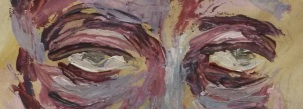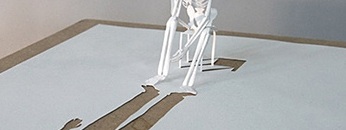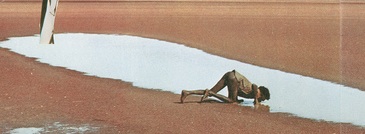Summative Assessment
Posted: May 6, 2016 Filed under: Uncategorized Leave a commentMemento Mori is the medieval practise that was designed to act as a ‘reminder of death’, the theory of which was used to reflect upon ones mortality and the temporary state of ones life on earth, as well as to raise awareness of the transience of nature itself. Re-enforcing this innate connection to the earth and the acceptance of our physical limits, including our inevitable death, was portrayed through dramatic and imposing imagery. Skulls were largely featured as a warning to the public, that what we have in this realm is only temporary.
I have taken this practice and explored the theory of Memento Mori in a modern western culture. Aware that our process of mourning, and relationship with death in our day-to-day lives, seems to be kept behind closed doors, to the point where we have lost the communal notion of death as a natural part of existing.
Thomas Macho writes about death, explaining that, ‘It is present because it is missing. It is an invisible picture on the wall, giving meaning to all other pictures.’ This has largely been the core of my investigation, taking Macho’s theory and developing provocative collages, using powerful imagery much like the churches of the medieval period, to establish a new perspective on Memento Mori. Encouraging the public to embrace the inevitability of death, and the innate connection we share with the universe, that we cannot have life without death. And what remains is an endless echo, this presence of absence, as death continues to complete the cycle of life.
DOCUMENTATION

Early Experiments: https://kairoscinco.wordpress.com/2015/10/29/early-experiments/
Looking at my early investigations into my brief. Reading forensic reports and attempting to successfully decipher the direction and attitude i wanted to take my work in. Although, throughout my working practice, it seemed apparent that i was losing sight of what i wanted to achieve out of this concept.

Start of Collage: https://kairoscinco.wordpress.com/2016/01/15/start-of-collage/
A shift takes place in my work, after reading several essays on death in modern western culture, i found the writing of Thomas Macho to be very influential. It was here that i began to experiment with the concept of a ‘presence of absence’, the physical form being present, but the emotional and mental self being absent. Seeking out a medium that would help visualise this concept, i shifted to collage, as i felt that the immediacy and strong visual nature of collage, proved to be more effective than my previous work.

Collage Animation: https://kairoscinco.wordpress.com/2016/04/25/collage-animation/
While still in the realm of collage, i began to experiment with animation, using stop motion as a way of building an impression of a human being, and then visualising the process of human decomposition, to reveal in essence all life itself. This was however, problematic in terms of execution, as well as presentation. I began to feel that the animation was contradicting the aesthetic and impact of my theme. using a closed off, dark environment was going against, the everyday perception of death i wanted to achieve in my final piece.

Final Collages: https://kairoscinco.wordpress.com/2016/05/02/final-collages/
Having been producing and experimenting with a wide range of images and collage techniques, i feel like i have built up a strong body of work. After deciding to not go ahead with the animation, i was reliant on the power of my collages to successfully communicate my theme to the viewer.

Final Composition: https://kairoscinco.wordpress.com/2016/05/06/final-composition/
In the final Stages, i was focussed on the composition of the piece as a whole. Trying to consider how the collages interact with each other, working together to create a final piece, while simultaneously allowing each image to independently communicate my theme. Being aware of the aesthetic of the overall appearance, i went through a process of elimination. I didn’t want there to be too many collages, incase the viewer lost focus and would glaze over the piece. And so i had to carefully select what i considered to be the most successful collages when attempting to purvey my concept.
CONTEXTUALISATION

Rose Waterson: https://kairoscinco.wordpress.com/2016/02/21/rose-waterson/
Rose Waterson’s work was very effective, and took the concept of a ‘presence of absence’ for an engaging level. I found her projection influential on my collage work, which in time, fed my approach to my animation. Waterson also became a good contact and was happy to discuss work with me, which i was grateful for. She introduced me to Seiko Kato, which then became another good contact.

Seiko Kato: https://kairoscinco.wordpress.com/2016/02/22/seiko-kato-2/
Kato’s work deals with life and death, much as my work has been. But Kato’s work is every intricate, and uses a lot of images from victorian illustration books and medical illustrations. I loved her embellishment of skulls, and she proved to be a great insight into an appropriate and alternative attitude to the same concept as my own. The skull has become iconic with the theme of death, but i was still trying to avoid any morbid cliches.

Peter Callesen: https://kairoscinco.wordpress.com/2016/03/24/peter-callesen/
I found encouragement from Callesen’s work, in the sense that less is more. Again, his images imply a presence of absence, but he has taken a different approach. While not all his pieces are macabre, i focused on his work that dealt with the human form. Using everyday materials, his work is playful and strikes to perfect tone, that i too wanted to achieve in my collages.

Katarzyna Kozyra: https://kairoscinco.wordpress.com/2016/03/06/katarzyna-kozyra/
Kozyra’s projection is very powerful. I felt i needed to look into other artists that had used similar techniques and projections as i had be experimenting with. although i felt Kozyra’s work was too forceful and imposing on the viewer. It’s what made me start to question the true effectiveness of a projection of a final piece in terms of viewer perception.

Joe Webb: https://kairoscinco.wordpress.com/2016/04/13/joe-webb/
Joe Webb has probably been one of the most influential collage artists for me. His themes can be quite politically based, and particularly poignant at times. But he still achieves a sense of light heartedness, and fun about his work. I really appreciate this balance of tone within his composition and it made me focus more on the strength of the images i was using. composition was key and would hold my work together.
Website: http://cargocollective.com/EFIllustration
Final Composition
Posted: May 6, 2016 Filed under: Documentation, Feild, Uncategorized 2 Comments
I felt like my work was always going to come together at the end, as the composition of the collages was integral to the pieces over all effectiveness. At first i lined them all out, but due to the variations of size and shape, it didn’t work as a uniform presentation. Also, i didn’t feel like it should be uniform, the whole point of the work is to feel like it could fit into the every day, i wanted variation, and for the collection to take a solid form, yet still allow each collage to stand out on their own. Having a jumbled effect, made the work seem more intriguing and would draw the eyes of the viewer to different one’s as they interact with the piece. Unbeknownst to me, the form of the whole collection, started to mimic the shape of an eye, which i thought was rather appealing, and would hopefully entice the viewer further. I also tried to bare in mind, the aesthetic of the piece as a whole. I didn’t want similar colours or compositions to be too close to each other, i really tried to focus on a balance within the piece so there was a sense of flow to the work overall. The spread of variation would mean that it’s easier for the viewer to interact with it, with the balance of warm and cold. Everything seemed to be focussed on the eye catching behavior of the piece as a whole, as well as considering how to ensure a close intimacy also being maintained.
Personal Statement
Posted: May 3, 2016 Filed under: Uncategorized Leave a comment
Memento Mori is the medieval practise that was designed to act as a ‘reminder of death’, the theory of which was used to reflect upon ones mortality and the temporary state of ones life on earth, as well as to raise awareness of the transience of nature itself. Re-enforcing this innate connection to the earth and the acceptance of our physical limits, including our inevitable death, was portrayed through dramatic and imposing imagery. Skulls were largely featured as a warning to the public, that what we have in this realm is only temporary.
I have taken this practice and explored the theory of Memento Mori in a modern western culture. Aware that our process of mourning, and relationship with death in our day-to-day lives, seems to be kept behind closed doors, to the point where we have lost the communal notion of death as a natural part of existing.
Thomas Macho writes about death, explaining that, ‘It is present because it is missing. It is an invisible picture on the wall, giving meaning to all other pictures.’ This has largely been the core of my investigation, taking Macho’s theory and developing provocative collages, using powerful imagery much like the churches of the medieval period, to establish a new perspective on Memento Mori. Encouraging the public to embrace the inevitability of death, and the innate connection we share with the universe, that we cannot have life without death. And what remains is an endless echo, this presence of absence, as death continues to complete the cycle of life.
Final Collages
Posted: May 2, 2016 Filed under: Documentation, Subject, Uncategorized 1 CommentSince shifting to collage, i’ve created a vast amount of images. However, i’ve had to go through a selective process. I was encouraged to put all of my collages up, which would number about 80-100, but i didn’t want to compromise on quality over quantity. I personally felt that some worked better than others, and if there was a wall filled, then people might be less likely to take the time to encage with the collages, but rather, glaze over the piece as a whole, losing the message behind them. While i’ve tried to ensure that the relationship between each image works as a whole piece, i wanted the strength of each individual collage to call out to the viewer. After selecting about 20, i laid them out and had to find a successful composition for them, but it was clear that i needed more. In the end, I decided that i wanted them as a kind of cluster of collages, to resemble the jumble of life, that this message is universal and should cater to everyone. Everyone is different and some will prefer some images more than others. I want the viewer to be able to chose what speaks to them most, But i’ve tried to ensure that each collage emulates my theme successfully. I also wanted the collages to be aesthetically pleasing because of the intimidating nature of my theme, i’d been struggling throughout this year to find and appropriate approach to portraying a modern day momento mori. And to have appealing imagery, re-enforces the sense that death is natural, and something to welcome into society, rather than be intimidated by it, and keep it behind closed doors.
Illustration Fair
Posted: April 20, 2016 Filed under: Documentation, Subject, Uncategorized Leave a commentI’ve been producing work along side my course, trying to secure myself as a freelance illustrator, as i feel that it would prove to be a successful venture for me after uni. It may be unrelated to my work at uni, but i still think that what i produce at any time, feeds all other work. I’m always learning new techniques and inspiration can come from anywhere. i’m really excited to push my work out there, selling pieces at different events, including the Brighton Illustration Fair at the end of May. My experience in third year has taught me a lot about what is expected of an artist in the working world, and has allowed me to prove to myself that i’m committed to this career choice. A feeling that i hope will spur me on the the end of this year, and beyond.
Alex Rose
Posted: April 20, 2016 Filed under: Contextualisation, Uncategorized Leave a comment
Alex Rose’s work reminds me of Lucas Simoes’ photographic pieces. But Rose has taken a softer approach, using photographs and pencil sketches to build up a visual feeling of an particular individual, and then gently begins to remove them from our memory. His work is just as provocative as Simoes’ and again, i love the use of eroding the figure, enhancing a sense of loss within the image. But his work holds a tenderness that i find really endearing. The people in the pieces seem to lament with the viewer this loss of self and bestows on the audience a kind of dramatic irony. That we can all unite in this inevitable fading of life. It made me think not only in terms of collage, but using particular materials like pencil and charcoal, substances that fade in time, and if touched, would lose their magnitude and presence. I tried to use this in my animation so that the material themselves act as a statement of decay and fading of the physical form. Then to cut away at the image would provoke this theme further. But Rose manages to maintain a delicate aesthetic that plays well with my concept, and i feel i can take a lot from this series, and use it both in my collage and animation.
John Stezaker
Posted: April 20, 2016 Filed under: Contextualisation, Uncategorized Leave a comment
This series by Stezaker, is again, another take on replacement imagery. Using vintage silhouettes that have become iconic over the years, and filling them with another monochrome still from a similar era. Much like Kolar’s work, it’s good to see the same technique being used in a different context. There are obviously repetitive methods one can fall into with collage, and at times i’ve been afraid that i’ve been fairly unoriginal in my techniques. But after seeing Stezaker’s work, it’s given me faith that there are reasons why certain techniques are successful, and have been reworked over the years. That’s the nature of being an artist, taking what’s already been done and doing something else with it. I’ve also found that the most effective collages seem to be the simplest. Using basic techniques, but focussing on the power of the chosen images themselves to communicate to the viewer. It’s given me more confidence in my work, and i feel better able to focus on the core of my theme, without the worry of over compensating with quantity within a single collage.
Building It Up
Posted: April 14, 2016 Filed under: Documentation, Subject, Uncategorized Leave a comment
So my collage collection has been building. It seems to be a habit now. It’s really engrossing and i get a lot of satisfaction from the process. I want to keep building my collection, so if i choose to display them, i will have a wide range to choose from. of course some are going to be better than others, and i have to be careful not to sacrifice quality over quantity.
Joe Webb
Posted: April 13, 2016 Filed under: Contextualisation, Uncategorized 2 CommentsI love Joe Webb’s work. His composition is so provocative and effective. I appreciate the time he takes over a single collage, understanding the power of imagery in this art form. Some are very simple and composed of two images, but it’s the relationship of these combined images that makes his work so successful. I love the dark humour present in each collage. There are obvious underlying messages here that are particularly political at times, but they’re done in such a way that one maintains a lightheartedness towards them. He’s managed to achieve the exact attitude i’m aiming for with my own collages. I feel that this medium has been most successful to portray my theme, due to this balance of provocative composition and playful images. They don’t have to be overloaded, they can be simple and effective. Webb’s work has really helped me develop my own practice and gauge a clearer understanding of the appropriate temper i wanted to strike in my work.
Jiri Kolar
Posted: April 13, 2016 Filed under: Contextualisation, Uncategorized Leave a comment
I really like kolar’s collage techniques. It’s easy to feel like you’re repeating yourself and sometimes it’s hard to find a different approach to collage, but Kolar has obviously taken the time to think about his pieces. Each one holds a heart of dedication and contemplation. They’re almost like optical illusions and some could become disorientating. But his work is still playful and the simplicity of it makes it seem quite timid and welcoming. I love his bird collages and the use of two images intertwined works really well. He takes the sense of a presence of absence and has done something different. We can see the original form of the bird, or the butterfly, but it has been replaced by another image underneath. This technique has definitely inspired me and i have experimented with my own take on it, as i feel it successfully communicates my theme and provides a playful attitude to the daily encounter of death.














































Recent Comments